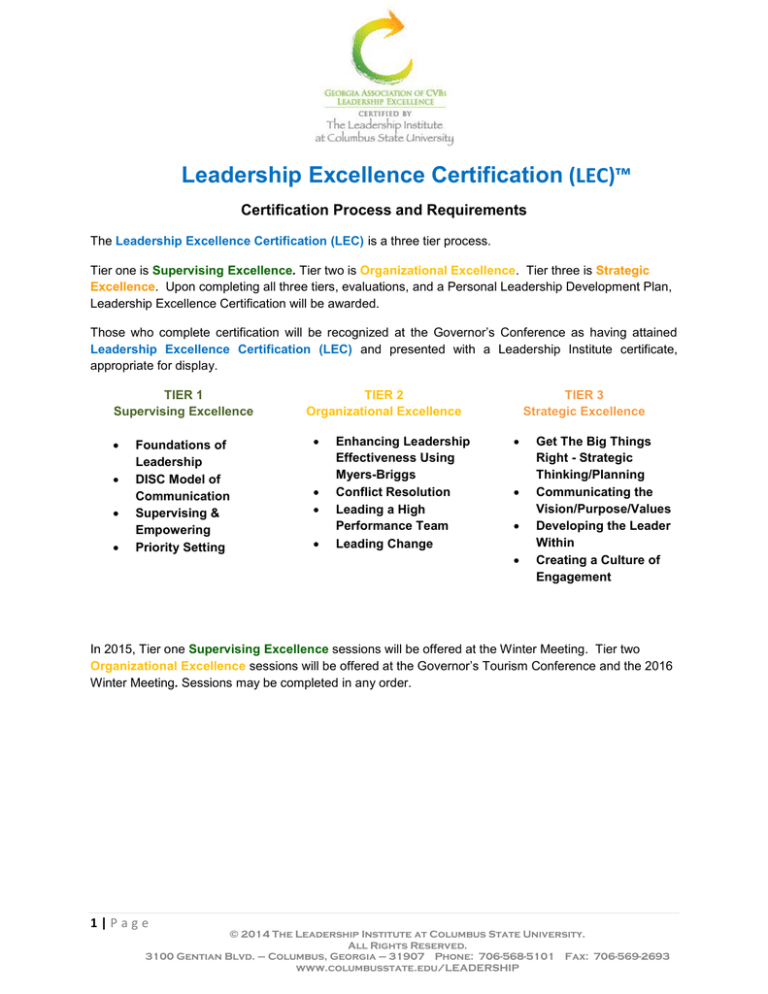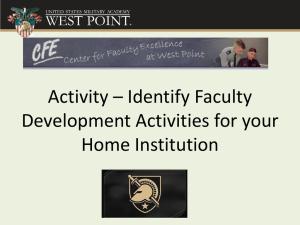
Leadership Excellence Certification (LEC)™
Certification Process and Requirements
The Leadership Excellence Certification (LEC) is a three tier process.
Tier one is Supervising Excellence. Tier two is Organizational Excellence. Tier three is Strategic
Excellence. Upon completing all three tiers, evaluations, and a Personal Leadership Development Plan,
Leadership Excellence Certification will be awarded.
Those who complete certification will be recognized at the Governor’s Conference as having attained
Leadership Excellence Certification (LEC) and presented with a Leadership Institute certificate,
appropriate for display.
TIER 1
Supervising Excellence
Foundations of
Leadership
DISC Model of
Communication
Supervising &
Empowering
Priority Setting
TIER 2
Organizational Excellence
Enhancing Leadership
Effectiveness Using
Myers-Briggs
Conflict Resolution
Leading a High
Performance Team
Leading Change
TIER 3
Strategic Excellence
Get The Big Things
Right - Strategic
Thinking/Planning
Communicating the
Vision/Purpose/Values
Developing the Leader
Within
Creating a Culture of
Engagement
In 2015, Tier one Supervising Excellence sessions will be offered at the Winter Meeting. Tier two
Organizational Excellence sessions will be offered at the Governor’s Tourism Conference and the 2016
Winter Meeting. Sessions may be completed in any order.
1|Page
© 2014 The Leadership Institute at Columbus State University.
All Rights Reserved.
3100 Gentian Blvd. – Columbus, Georgia – 31907 Phone: 706-568-5101 Fax: 706-569-2693
www.columbusstate.edu/LEADERSHIP
NOTE: Titles of classes listed below are subject to change in order to fit the “theme” of the Governor’s Conference and/or Winter Meeting, the
content of each course will remain the same.
Supervising Excellence – Tier 1
Foundations of Leadership
Introduction to the key areas of leadership development and establishes a baseline for leadership growth and
enhancement. Participants will gain an appreciation of core leadership principles, learn about different
leadership styles, and have a foundation for leadership development and professional growth.
Not Right or Wrong, Just Different: Understanding Yours and Others Behavior & Personality
through DISC
People are influenced and motivated differently! Have you ever wondered why you can say one thing to one
person, and get a certain response, then say exactly the same thing to another person, and get a different
response? The basic reason is because people have different personality styles, and each personality has a
different priority. Knowing personality styles helps you to understand yourself and others! This session will
introduce attendees to DISC (“D” is the Dominant type; “I” is the Inspiring type; “S” is the Supportive type; “C”
is the Cautious type). This information will help attendees to better understand themselves and others as a
first step towards better communication and understanding in the workplace and at home.
Setting Priorities from the Inside Out
Why is it so hard to follow through on time management/priority setting advice? Most programs or books offer
tips and advice but gloss over the practical implementation. They say, “Increase your productivity and fill each
moment with activity” or “simplify, simplify, simplify”. We know everyone is different - some like a fast pace;
others like a slower one; some people are night owls; others are at their best in the morning; some people love
structure; others thrive on spontaneity and flexibility. In this session we will learn about and use a system
created by Julie Morgenstern dubbed “The Queen of putting people’s lives in order” by USA Today to develop
your big picture view, find out what’s holding you back, design a plan that fits your personality, makes choices
about & take ownership in your schedule and your life.
Supervising and Empowering
This session encourages leaders to develop direct reports through empowering assignments and leadership
development exercises that result in professional growth and competence. Participants will know the
difference between a boss and a leader and will be enabled to develop others.
2|Page
© 2014 The Leadership Institute at Columbus State University.
All Rights Reserved.
3100 Gentian Blvd. – Columbus, Georgia – 31907 Phone: 706-568-5101 Fax: 706-569-2693
www.columbusstate.edu/LEADERSHIP
Organizational Excellence – Tier 2
Enhancing Your Leadership Effectiveness
st
Leaders for the 21 Century must understand that leadership requires enhancing relationships and creativity
among team members. Caring, showing interest, fairness, demonstrating trustworthiness, and understanding
while at the same time managing ambiguity, diversity, and system complexity are directly related to the
st
success of the 21 century leader. Using MBTI (Myers-Briggs Type Indicator) participants will understand
their own leadership psychology. Participants will gain insights into the needs of those around them who are
essential to fulfilling organizational goals. Participants will learn that failure and success are primarily tied to
developing constructive relationships among members of the team; having effective communication between
leader and team members; and demonstrating the value of human differences.
Working with You is Killing Me – Conflict Resolution
People don’t leave work, they leave people. The toughest part of any job is dealing with the people around
you. Using Thomas-Kilmann Conflict Mode Instrument participants will understand the process of conflict and
its resolution. Conflict is not fun for most of us but avoiding it can cause irreparable damage to you and your
team. Clarifying the facts, the players, and the positions in the conflict are key to the start of a REAL
discussion on the most workable options to move to the most positive outcome and answer what are the
legitimate needs and concerns of the people involved.
Leading a High Performance Team
Trust, agility, communication, and systematic encouragement are the pillars of high performance teams.
Participants will have the opportunity to diagnose and rate the equalities that make a team effective. We will
also discuss Lencioni’s ‘Five Dysfunctions of a Team’ that will diminish performance and effectiveness.
Change is Good, You Go First! – Leading Change
Using John Kotter’s, ‘The Heart of Change’ participants will focus on the impact of change, review the 8 steps
in the change process, be equipped to be proactive rather than reactive to change, enabled to better lead an
organization in a rapidly changing environment and understand the skills necessary to take charge of change.
3|Page
© 2014 The Leadership Institute at Columbus State University.
All Rights Reserved.
3100 Gentian Blvd. – Columbus, Georgia – 31907 Phone: 706-568-5101 Fax: 706-569-2693
www.columbusstate.edu/LEADERSHIP
Strategic Excellence – Tier 3
Get the Big Things Right - Your Future Depends on It
Participants will work through the elements of strategic planning: Vision, Strategy, Leadership (Direction,
Movement, and Alignment) and Measurement. The ability to recognize the difference between tactical and
strategic planning and thinking will become clear. Participants will gain a deeper appreciation for the impact of
vision. This session will provide the building blocks for a strategic plan for your CVB.
Get Engaged Without the Ring - Creating a Culture of Engagement
According to Gallup 7 out of 10 workers are apathetic or totally disengaged. The root cause – Dysfunctional
organizational culture. Participants will learn about the impact culture has on an organization and discuss how
to create an engaging environment that motivates, stretches and inspires your team. The climate and culture
of an organization is determined by a variety of factors, including artifacts, espoused beliefs and values, and
underlying assumptions. Participants will understand what organizational culture means, what influence
culture has on an organization, and discuss how one goes about building, influencing, or changing an
organization’s culture.
Walk the Talk - Communicating Vision, Purpose, & Values
A successful organization has a carefully crafted vision, a clearly articulated core purpose, and a code of
values that are non-negotiable. The leader must systematically communicate vision, purpose, and values in a
way that will inspire, motivate and align the team.
What Got You Here Won’t Get You There - Developing the Leader Within
A personal commitment to individual leadership development is essential for growth and advancement. Your
present have are unlikely to be enough for the challenges in the future. The bottom line is, those who are
personally committed to grow and adapt will be the most successful and have a greater sense of well-being.
Participants will gain a renewed personal commitment to actively and continuously work at leadership
development; an understanding that different situations and levels of responsibilities will call for different skills
and approaches; create an ACTION strategic developmental plan that enhances strengths and compensates
for weaknesses and establish a system of feedback and accountability.
4|Page
© 2014 The Leadership Institute at Columbus State University.
All Rights Reserved.
3100 Gentian Blvd. – Columbus, Georgia – 31907 Phone: 706-568-5101 Fax: 706-569-2693
www.columbusstate.edu/LEADERSHIP
Leadership Excellence Certification Maintenance
Leadership Excellence Certification (LEC) recipients are required to complete annual leadership
training in order to maintain certification. Four hours annually must be completed in order for LE
certification to remain valid. The Cunningham Center for Leadership Development and the LEC
committee recognizes five methods of satisfying this requirement:
Submission of Outside Course Materials to the LEC committee for review:
o Submit materials from any leadership development course, conference, seminar or
workshop, online or in person, taken outside of The Cunningham Center for Leadership
Development related to Leadership Development to the LEC committee for review and
approval towards certification maintenance.
Annual Course Offerings at Govenor’s Conference/GACVB Annual Meeting:
o Participate in advanced leadership development courses offered by The Cunningham
Center for Leadership Development at the annual Governor’s Conference and/or the
GACVB Annual Meeting.
College or University Courses:
o The successful (‘B’ or better) completion of a College or University course related to
Leadership Development.
Petition
o Submit petition along with appropriate materials to be reviewed by the LEC committee for
possible acceptance as LEC maintainence hours.
Lapsed Certification:
If an individual does not complete the four required hours of certification maintenance their LE
certification will go into an “Inactive” status.
While “Inactive” the individual is not permitted to use the LEC credential.
An individual may return to an “Active” status by applying for reinstatement.
In order to have certification reinstated, the individual must pay a reinstatement fee of $65 and
submit documentation of 4 hours of leadership development maintenance work.
If no reinstatement application or payment is received within the nine months following the
notification of “Inactive” status, certification is lapsed and the individual is notified by a method
that requires a signature upon receipt that he/she is no longer Leadership Excellence Certified.
To regain the LEC credential, an individual with a “Lapsed” certification status must participate in
8 hours of Leadership Development offered through GACVB at the annual Governor’s
Conference and winter meeting by The Cunningham Center for Leadership Development.
5|Page
© 2014 The Leadership Institute at Columbus State University.
All Rights Reserved.
3100 Gentian Blvd. – Columbus, Georgia – 31907 Phone: 706-568-5101 Fax: 706-569-2693
www.columbusstate.edu/LEADERSHIP


